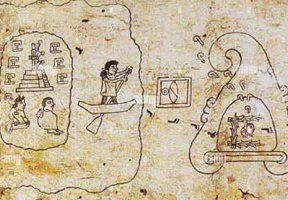By: Daniel Nardini
 Despite the economic prosperity of Mexico under then President Porfirio Diaz, much of Mexico’s population, especially its native peoples, remained deeply impoverished. Social and class inequalities were serious issues for most of Mexico’s people. In the same year that the National Museum of Archaeology, History and Ethnography opened to the public, 1910 marked the beginning of the Mexican Revolution. For the next ten years, Mexican and rebel armies would fight many battles as the revolution impacted many aspects of the country’s people. Millions of Mexicans were forced to flee from one region to the next, and many Mexicans even fled into the United Stated from the northern Mexican states along the U.S.-Mexico border. The main focus of the revolution became the fight for the rights of Mexico’s poor, especially the indigenous peoples, land rights, and a more stable political infrastructure and constitution where the people had a say in their government.
Despite the economic prosperity of Mexico under then President Porfirio Diaz, much of Mexico’s population, especially its native peoples, remained deeply impoverished. Social and class inequalities were serious issues for most of Mexico’s people. In the same year that the National Museum of Archaeology, History and Ethnography opened to the public, 1910 marked the beginning of the Mexican Revolution. For the next ten years, Mexican and rebel armies would fight many battles as the revolution impacted many aspects of the country’s people. Millions of Mexicans were forced to flee from one region to the next, and many Mexicans even fled into the United Stated from the northern Mexican states along the U.S.-Mexico border. The main focus of the revolution became the fight for the rights of Mexico’s poor, especially the indigenous peoples, land rights, and a more stable political infrastructure and constitution where the people had a say in their government.
The amazing thing about the revolution was despite the widespread destruction, the vast collections of Mexico City’s museum remained intact. When the revolution ended in 1920, the museum’s vast collection had increased to over 52,000 items. By 1940, the museum was divided into two completely separate entities; the National Museum of History which dealt with the history of Mexico from the Spanish colonial period to the then current era, and the National Museum of Anthropology which dealt with the period before the Spanish colonial era. The National Museum of Anthropology drew in many new artifacts that had been discovered over the decades. By 1963, the museum was no longer able to hold the vast collection it had, so a new had to be constructed. The new museum, designed by the great Mexican architect Pedro Ramirez Vazquez, took into consideration the most modern designs for the time and the indigenous architectural designs that had been part of Mexico’s native people’s past. The result was a beautifully designed museum that encompasses outside exhibits and gardens as well as 23 rooms dedicated to Mexico’s indigenous past. Opened in 1964 under then Mexican President Adolfo Lopez Mateos, the museum is the country’s crowning achievement in searching for its identity.
The National Museum of Anthropology is far from being the only museum dedicated to Mexico’s Spanish colonial and indigenous past. There are state and local museums that have been founded over the decades equally dedicated to the native cultures and pre-histories of the local areas. Anthropological and archaeological studies continue throughout Mexico, and even Mexico City which was once the capital of the Aztec Empire. Excavations are continually being carried out in an effort to learn more what the former Aztec capital Tenochtitlan might have been like. Even the local arts and handicrafts are influenced by the native people’s cultures in their local areas. Likewise, many famous Mexican artists have been influenced by the country’s indigenous arts. Works by famous Mexican artists such as Diego Rivera (1886 to 1957), Frida Kahlo (1907 to 1954), David Alfaro Siqeuiros (1896 to 1974), Antonio Gonzalez Orozco (1933 to 2020), and Desiderio Hernandez Xochitiotzin (1922 to 2007) among others, were influenced by the indigenous peoples of pre-Spanish Mexico. Today, Mexicans as well as tourists from other countries can see and come to understand the arts, cultures and architectural marvels of its indigenous peoples as well as the rich Spanish colonial heritage of Mexico.











